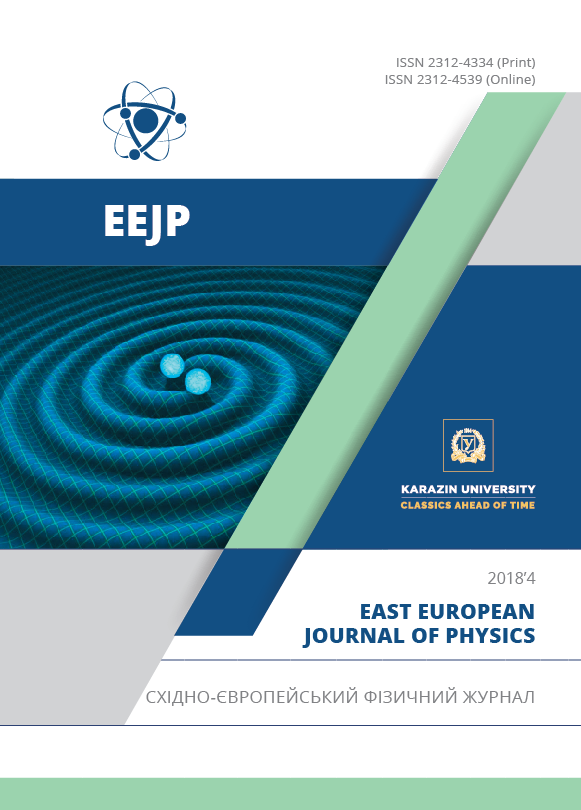Розвиток гелієвої пористості при відпалі імплантованою гелієм сталі X18H10T
Анотація
Кінетика процесів розвитку гелієвої пористості при відпалі нержавіючої сталі Х18Н10Т, опроміненої іонами гелію з енергією 20 кеВ при кімнатній температурі для одночасного створення зміщуючих пошкоджень на рівні 0,5-5 зна і концентрації гелію 1-12 ат.% досліджена методами електронної мікроскопії та термодесорбційної спектрометрії. Визначено температурні інтервали виходу гелію зі сталі та їх залежність від дози опромінення. Досліджено еволюцію мікроструктури сталі Х18Н10Т в процесі постімплантаційних відпалів в інтервалі температур від Ткімн до 1420 К. При дозі опромінення 1·1020 м-2 гелієві бульбашки були виявлені тільки після відпалу до температури 890 К, при дозі 1·1021 м-2 бульбашки спостерігалися відразу після опромінення при Ткімн. В процесі відпалу середній діаметр бульбашок змінюється від ~1 нм при Ткімн до 10-20 нм при Твідп 1420 К. Розглянуто механізми зростання бульбашок або шляхом міграції і коалесценції, або за механізмом Оствальда – розчинення і перезахоплення. Оскільки кожному з цих механізмів відповідає певний тренд залежності розмірів і щільності бульбашок від температури відпалу, побудовані і проаналізовані температурні залежності середніх діаметрів і щільності гелієвих бульбашок для дози 1·1021 м-2. Експериментальні дані характеризуються трьома температурними інтервалами: 1 - від 300 до 760 К, 2 - від 760 до 1030 К і 3 - від 1030 до 1350 К з трендами, які явно різняться. У низькотемпературній області діаметр і щільність бульбашок практично не змінюється. При відпалі в області температур від 760 до 1030 К починається зростання їх розмірів і зниження щільності. Ця тенденція посилюється в області температур 1030-1420 К. Виконано оцінку енергії активації процесів, які контролюють механізм росту бульбашок в області температур 1000-1420 К. Отримано значення ~3,7 еВ, яке добре корелює з теоретично розрахованою величиною енергії активації процесу дисоціації (EHediss ) за механізмом Оствальда.
Завантаження
Посилання
V.N. Voyevodin, I.M. Neklyudov, Evolution of the structure phase state and radiation resistance of structural materials (Кiev, Naukova Dumka, 2006), P. 374. (in Russian)
S.J. Zinkle, J.T. Busby, Mater. Today. 12(11), 12 (2009).
H. Ullmaier, Nucl. Fusion. 24(8), 1039 (1984).
Y. Dai, G. R. Odette and T.Yamamoto, Comprehensive Nuclear Materials. 1, 141 (2012).
G.D. Tolstolutskaya, S.A. Karpov, G.Y. Rostova, S. B. Sungurov, G.N. Tolmachova, Вісник ХНУ. Фізика, [Visnyk KhNU. Physics] 23, 66 (2015).
B. Singh, H. J. Trinkaus, Nucl. Mater. 186, 153 (1992).
H. Trinkaus, B.N. Singh, J. Nucl. Mater. 323, 229 (2003).
K. Ono, K. Arakawa, M. Oohashi, H. Kurata, K. Hojou, N. Yoshida, J. Nucl. Mater. 283-287, 210 (2000).
V.I. Bendikov, A.V. Nikitin, V.V. Ruzhytskyi, V.F. Rybalko, S.M. Khazan, PAST. Series: Physics of Radiation Effects and Radiation Materials Science. 1(64), 65 (1996). (in Russian)
J. Rothaut , H. Schroeder & H. Ullmaier, Philos. Mag. 47, 781 (1983).
J. Chen, S. Romanzetti, S.W. Fommer, H. Ullmaier, J. Nucl. Mater. 304, 1 (2002).
Автори, які публікуються у цьому журналі, погоджуються з наступними умовами:
- Автори залишають за собою право на авторство своєї роботи та передають журналу право першої публікації цієї роботи на умовах ліцензії Creative Commons Attribution License, котра дозволяє іншим особам вільно розповсюджувати опубліковану роботу з обов'язковим посиланням на авторів оригінальної роботи та першу публікацію роботи у цьому журналі.
- Автори мають право укладати самостійні додаткові угоди щодо неексклюзивного розповсюдження роботи у тому вигляді, в якому вона була опублікована цим журналом (наприклад, розміщувати роботу в електронному сховищі установи або публікувати у складі монографії), за умови збереження посилання на першу публікацію роботи у цьому журналі.
- Політика журналу дозволяє і заохочує розміщення авторами в мережі Інтернет (наприклад, у сховищах установ або на особистих веб-сайтах) рукопису роботи, як до подання цього рукопису до редакції, так і під час його редакційного опрацювання, оскільки це сприяє виникненню продуктивної наукової дискусії та позитивно позначається на оперативності та динаміці цитування опублікованої роботи (див. The Effect of Open Access).








